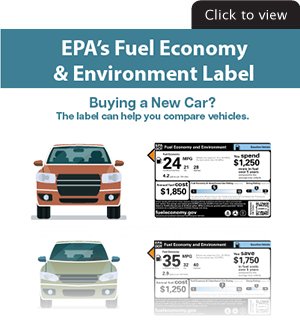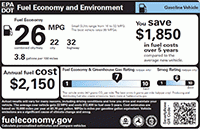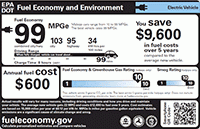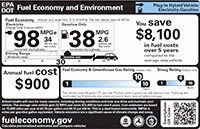Learn about the Fuel Economy Label
On this page:
A New Generation of Labels for a New Generation of Vehicles

In 2012, EPA and the National Highway Traffic Safety Administration (NHTSA) unveiled the most dramatic overhaul to vehicle fuel economy labels since they were introduced more than 35 years ago.
Car buyers now have more information than ever before-- including fuel economy, fuel costs, and environmental impacts such as smog and greenhouse gas ratings-- for all new vehicles, including advanced technologies such as electric cars and plug-in hybrids (PHEVs).
So you can now make comparisons – car by car – to save on fuel costs and reduce your emissions!
The redesigned label includes:
- How much you'll save or spend on fuel over the next five years, compared to the average new vehicle
- Ratings on a vehicle's smog and greenhouse gas (GHG) emissions
- Driving range and charging time for electric vehicles
- QR Code® to access additional information online on your smartphone
Why are there different ratings for smog and GHG Emissions?
About the Labels
Looking to Sell a Used Car? We Have a Label for That, Too
The benefits of a vehicle fuel economy and environment label now extend to the used car market, too. If you are selling a car or truck, you can print or download a used vehicle label on fueleconomy.gov, making it easy for you to provide fuel economy and CO2 information for your vehicle. The web-tool allows you to easily search by model year, make, model, engine, and transmission options to find the appropriate vehicle.
http://www.fueleconomy.gov/feg/UsedCarLabel.jsp
The used vehicle label displays:
- the fuel economy and CO2 grams per mile;
- a stock photo of the vehicle; and
- a QR code that shoppers can scan with a smartphone to personalize the fuel economy information with their annual mileage, percent of driving in the city, and current fuel prices.
The electronic label graphic can be downloaded and included in online advertisements on the web, while the paper label can be printed and affixed to the vehicle window. As a vehicle’s fuel economy changes very little over a typical 15-year life with proper maintenance, the original EPA fuel economy estimate remains the best indicator of a used vehicle’s average gas mileage.
Evolution of the Label




